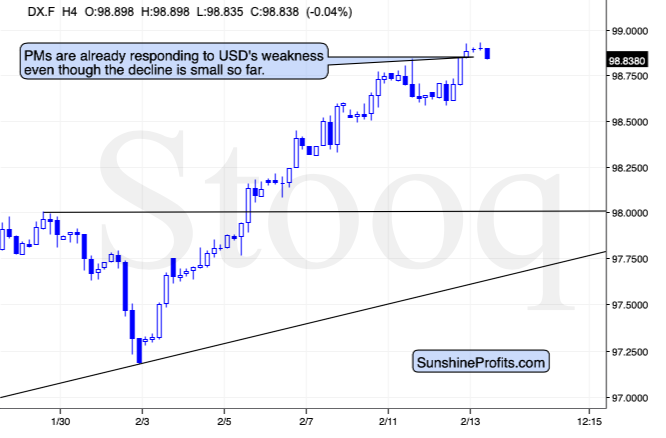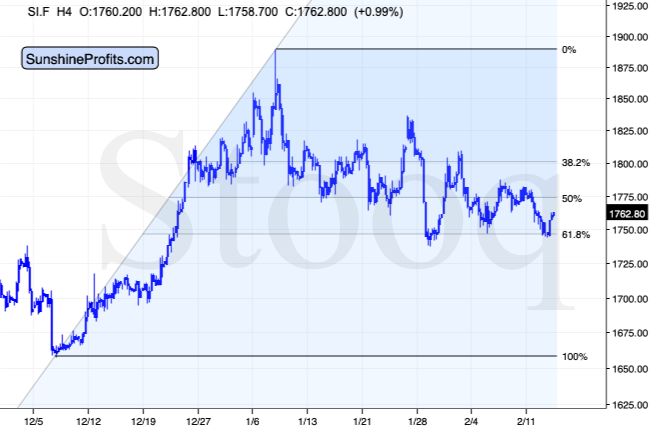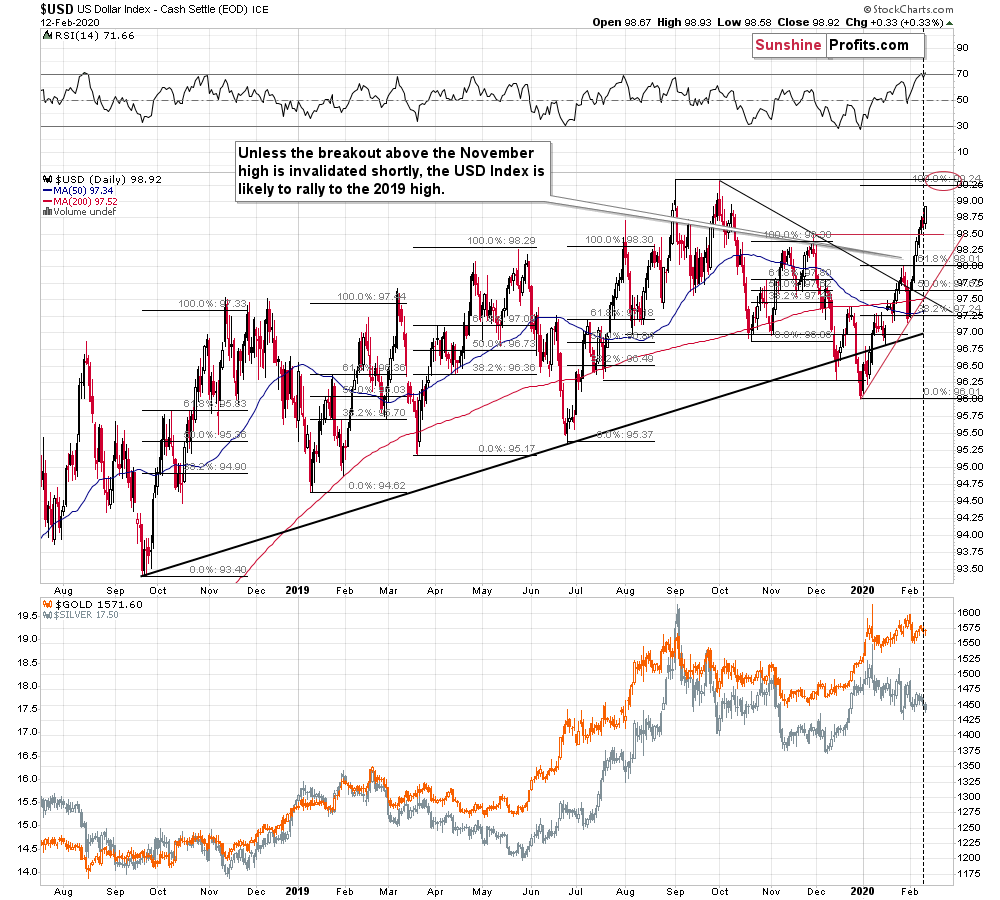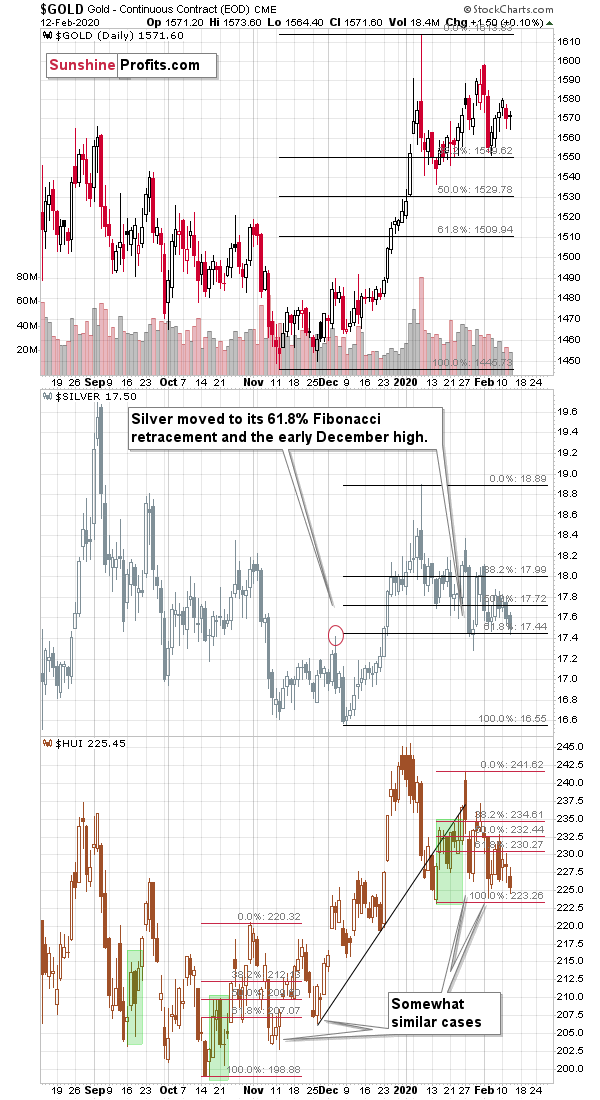Briefly: in our opinion, full speculative long positions (150% of the regular position size) in silver is justified from the risk/reward point of view at the moment of publishing this Alert.
The outlooks for the USD Index and the precious metals market are exactly the same as they were yesterday. PMs are likely to decline significantly in the medium term, but they are likely to rally in the very short term.
The USDX moved up and PMs moved down yesterday, which might seem to contradict the above, but it doesn't.
In the last 24 hours, the USD Index moved higher and then declined less than it had rallied.
At the same time both gold and silver moved lower, and then rallied more than they had declined.
PMs are showing exceptional short-term strength relative to what the USD Index is doing. Just as gold and silver are providing ridiculous amounts of very strong indications that the are going lower in the following months, they are providing ridiculously strong signals that they are not going to decline far unless they rally first.
The very short-term decline in the USDX and the very short-term rally in the PMs wasn't cancelled - it was just slightly delayed.
Let's take a look at the details.
Short-Term USDX and PMs Dynamics
The above 4-hour chart (for those who are new to technical analysis - 4-hour chart means that each candlestick represents 4 hours - not that the entire chart covers the last 4 hours) shows that the USDX is finally starting to roll over, but that this move is tiny so far.
And yet...
The move in the PMs (the above chart features silver futures) is already relatively visible.
Also, please note that silver just once again refused to decline below the 61.8% Fibonacci retracement level based on the December - January rally. If anyone doubts the usefulness of the Fibonacci retracements, the above serves as a good example thereof.
What was the USD Index doing while silver was refusing to move visibly below $17.50?
Longer-Term USDX and PMs Dynamics
It's been rallying! PMs refused to respond to dollar's near-vertical upswing. Why would they do that? Because they are not ready to decline just yet. They need to correct to the upside one more time (at least) before being ready to slide. And that's in perfect tune with what happened after other huge-volume tops - similar to the January 2020 one.
It seems that we might not get more than one corrective upswing before the big plunge after all. At least that's what the mining stocks are suggesting.
The Immediate PMs Outlook
Miners' performance was relatively weak recently compared to the one of gold, indicating that the early part of the upswing is well over and that we are now in its final round. The only thing missing is silver's sudden outperformance. Based on how silver is responding to even a tiny decline in the USDX, it seems that we won't have to wait for this final sign for much longer.
Summary
Summing up, it seems that the precious metals market is about to form the final medium-term top, and start another major move lower. Based on the likelihood of seeing a short-term decline in the USD Index, we might see the final very short-term upswing in PMs and miners first, but it's not likely to take more than a few days. In fact, the rally and top might even form as early as today.
In our opinion, once silver hits $17.89, your profits from the long position should be automatically taken off the table. We will let you know manually once we want to open short positions in gold, silver, or mining stocks.
As always, we'll keep you - our subscribers - informed.
To summarize:
Trading capital (supplementary part of the portfolio; our opinion): Full speculative long position (150% of the full position) in silver is justified from the risk/reward perspective with the following stop-loss orders and binding exit profit-take price levels:
- Silver futures: profit-take exit price: $17.89; stop-loss: $17.24; initial target price for the USLV ETN: $90.47; stop-loss for the USLV ETN: $82.95
Long-term capital (core part of the portfolio; our opinion): No positions (in other words: cash)
Insurance capital (core part of the portfolio; our opinion): Full position
Whether you already subscribed or not, we encourage you to find out how to make the most of our alerts and read our replies to the most common alert-and-gold-trading-related-questions.
Please note that the in the trading section we describe the situation for the day that the alert is posted. In other words, it we are writing about a speculative position, it means that it is up-to-date on the day it was posted. We are also featuring the initial target prices, so that you can decide whether keeping a position on a given day is something that is in tune with your approach (some moves are too small for medium-term traders and some might appear too big for day-traders).
Plus, you might want to read why our stop-loss orders are usually relatively far from the current price.
Please note that a full position doesn't mean using all of the capital for a given trade. You will find details on our thoughts on gold portfolio structuring in the Key Insights section on our website.
As a reminder - "initial target price" means exactly that - an "initial" one, it's not a price level at which we suggest closing positions. If this becomes the case (like it did in the previous trade) we will refer to these levels as levels of exit orders (exactly as we've done previously). Stop-loss levels, however, are naturally not "initial", but something that, in our opinion, might be entered as an order.
Since it is impossible to synchronize target prices and stop-loss levels for all the ETFs and ETNs with the main markets that we provide these levels for (gold, silver and mining stocks - the GDX ETF), the stop-loss levels and target prices for other ETNs and ETF (among other: UGLD, DGLD, USLV, DSLV, NUGT, DUST, JNUG, JDST) are provided as supplementary, and not as "final". This means that if a stop-loss or a target level is reached for any of the "additional instruments" (DGLD for instance), but not for the "main instrument" (gold in this case), we will view positions in both gold and DGLD as still open and the stop-loss for DGLD would have to be moved lower. On the other hand, if gold moves to a stop-loss level but DGLD doesn't, then we will view both positions (in gold and DGLD) as closed. In other words, since it's not possible to be 100% certain that each related instrument moves to a given level when the underlying instrument does, we can't provide levels that would be binding. The levels that we do provide are our best estimate of the levels that will correspond to the levels in the underlying assets, but it will be the underlying assets that one will need to focus on regarding the signs pointing to closing a given position or keeping it open. We might adjust the levels in the "additional instruments" without adjusting the levels in the "main instruments", which will simply mean that we have improved our estimation of these levels, not that we changed our outlook on the markets. We are already working on a tool that would update these levels on a daily basis for the most popular ETFs, ETNs and individual mining stocks.
Our preferred ways to invest in and to trade gold along with the reasoning can be found in the how to buy gold section. Additionally, our preferred ETFs and ETNs can be found in our Gold & Silver ETF Ranking.
As a reminder, Gold & Silver Trading Alerts are posted before or on each trading day (we usually post them before the opening bell, but we don't promise doing that each day). If there's anything urgent, we will send you an additional small alert before posting the main one.
Thank you.
Sincerely,
Przemyslaw Radomski, CFA
Editor-in-chief, Gold & Silver Fund Manager







